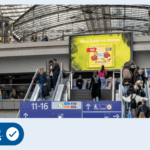Public Media is making progress in terms of AI: McDonald’s and Burger King are battling it out with the help of ChatGPT, the Swiss FDP is relying on AI-generated motifs in its election campaign, and even creative tests are already working with the help of AI. We have the first cases. But in an international intermedia comparison, we are lagging behind, at the latest since Google and Facebook are already offering (selected) customers the entire advertising cascade via AI – from motif creation to planning and placement to evaluation. It is to be feared that this will further shift the balance of power in the advertising market. The U.S. multinationals are already reporting rising advertising revenues again.
AI acts as an additional booster because tools such as Google’s Performance Max, with its easy handling, also enable the numerous small and medium-sized companies to get started in advertising or make it easier to handle. And because Alphabet and Meta have a virtual monopoly with their walled gardens, they do not need to take market usages and standards into account. All in all, this has a self-reinforcing effect.
This increases the pressure on all other advertising media – including outdoor advertising. Good: We have the basic structural prerequisites to benefit from technological developments. Outdoor advertising is on the upswing: According to Nielsen, we are currently the only major media category to record significant growth (plus 6 percent). This is significant because outdoor advertising is digitizing more and more spaces, playing out more and more campaigns programmatically, and leveraging interactions with other media, especially mobile. This means we cover the entire public media sector.
Bad: We tend to get bogged down. The long road to a uniform currency is an example of this: IDOOH’s predecessor DMI developed the “Private & Public Screens” study, Ströer is on the market with its own reach currency. Media Frankfurt, the advertising marketer for Frankfurt Airport, launched the new airport currency Airport Audience Measurement (AAM) with JCDecaux almost two years ago, and MA Plakat became MA Out of Home. Diversity in the market is desirable for our customers. On the genre level, it is poison because harmonizing the different approaches takes time and we fall behind in intermedia competition. That then costs advertising money.
It is in the interest of the entire industry to hope that we do not make this mistake with the implementation of AI solutions. We can only master this new gigantic challenge together. Otherwise, we will end up with duplicate structures and individual solutions and thus lost time. The current technological development in our segment gives cause for optimism: In the programmatic area, new layers have been added to the exploitation chain with the DSPs and the SSPs. Platforms that can be used by everyone in the industry. Such technologically agnostic openness has given us a powerful boost in the advertising market.
It would also be desirable when it comes to AI. Starting with predictive analytics, consumer movement, creative solutions with appropriate upstream testing, and completely AI-based programmatic circuitry and billing. Here we need interoperability quickly, i.e., a rapid understanding of technical standards.
Demanding that is undoubtedly many times easier than implementing it. But it is hopefully a thought-provoking, first step toward a common AI agenda 2024. Less as a flowery vision, but rather as a common strategic approach to how we want to approach the topic of AI in a structured way and, above all, also implement it. Otherwise, even more advertising money will roll in the direction of Meta and Google.
Source: https://www.horizont.net/medien/kommentare/appell-zur-zusammenarbeit-warum-out-of-home-eine-ki-agenda-2024-braucht-213862?crefresh=1












